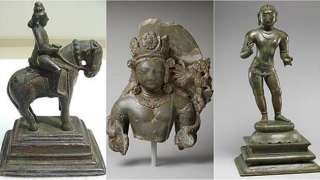MEDIA
Indian treasures in US museum: Western institutions must move beyond talk of decolonisation
www.indianexpress.com | March 15, 2023
Reports about artefacts stolen and smuggled to foreign shores should make museums reflect on their ethics, existence, and curatorial decisions
Over the last couple of days, reports about stolen artefacts that have reached foreign museums have been published in The Indian Express (‘India treasure trove sitting in US museum is linked to smuggler in Tamil Nadu jail’, March 14; ‘An untold Kashmir story: Artefact snot traced, FIRs gathering dust’, March 15). For anyone from the Subcontinent who has visited the Met in New York or the Louvre in Paris, similar concerns arise when arriving at the Asian or African art sections of several museums in the West. How did all of this even get there, one might ask.
While the reports published in The Indian Express clearly suggest that several artefacts were stolen and then perhaps smuggled to foreign shores, episodes like these should also make museums reflect on their ethics, existence, and curatorial decisions. So much African art in French museums? Can it be viewed without reflecting on the history of colonialism? Is the museum a civilisational project for the former coloniser? Is it trying to offer benign patronage while attempting to archive and safeguard African art? Who is trying to archive whose history? And what is African or Asian art, anyway? These are artificial, homogeneous categories, just like South Asian art or literature. We become prisoners of these categories. Our imagination is often hijacked by Western constructs and frameworks to view our own art and culture practices.
Questions like these offer an occasion for reflection and debate. We need a great deal of both. To see the Asia or Africa sections in some of the museums, people from these places have to pay a hefty sum for entry. Besides, access to these spaces is also restricted to a handful who can afford to go abroad. What about those who can’t? Doesn’t it amount to a kind of neo-colonialism? A few years ago, a wonderful exhibition of Kalighat paintings was on view at the Victoria Memorial in Kolkata, having arrived on loan from the Victoria and Albert Museum in London. According to the V&A website, it holds the largest collection of Kalighat paintings in the world. Imagine this absurd situation: Looking at Kalighat paintings that were made in Kolkata but have now been borrowed from London.
Some say that these art collections are better off abroad, that they will be well looked after and preserved. New York, Paris and London are great centres of the art world, after all. Perhaps, one cannot expect museums to give up their collections. But what if these collections could be shown at regular intervals in the countries of their origin? This would give access to so many who cannot otherwise view this art. What if countries could collaborate on such projects and the exhibitions could travel across the country? I know logistical challenges would be enormous but it certainly doesn’t seem impossible. Or what if a massive people’s art project, such as the Kochi Muziris Biennale, could include these artefacts in their curation and final display?
The museum must rethink its role in contemporary times. For those who cannot go to the museum, the museum should think of reaching them. People’s participation is not a one-way process, after all. Institutions in the West, especially, ought to consider a major course correction if they want to move beyond all the glib talk surrounding decolonisation and translate it into serious action.
Prof. Kunal Ray is the faculty of English Literature at FLAME University.

